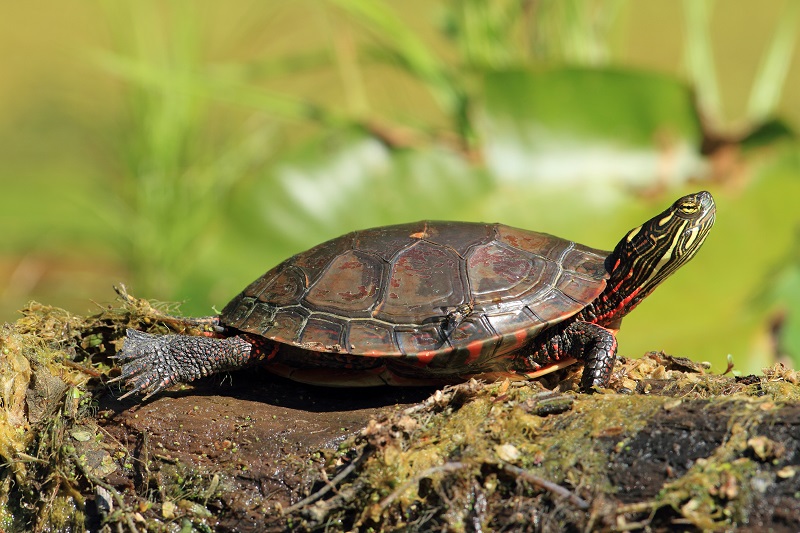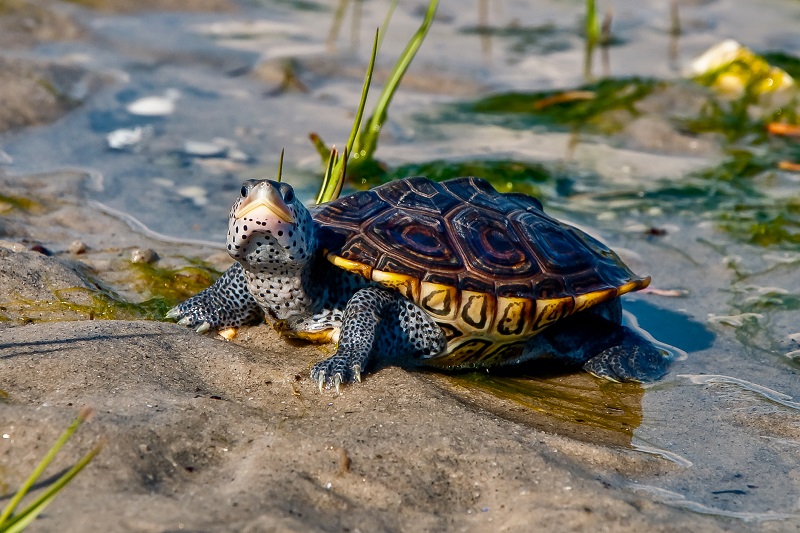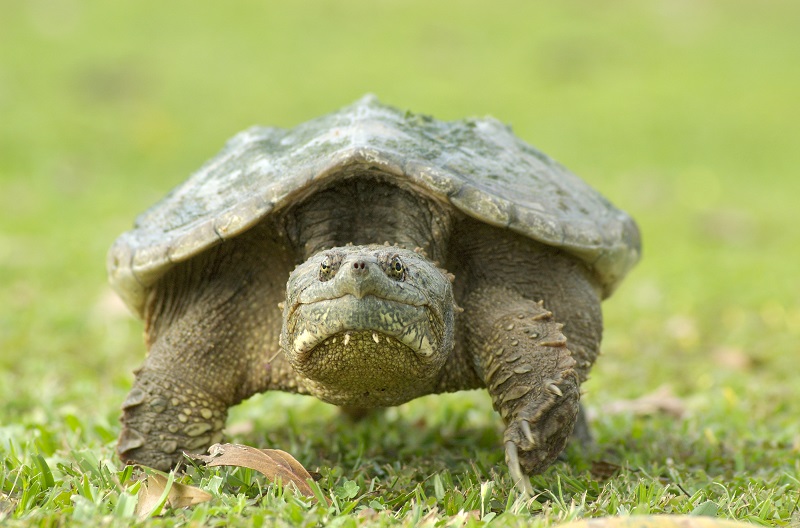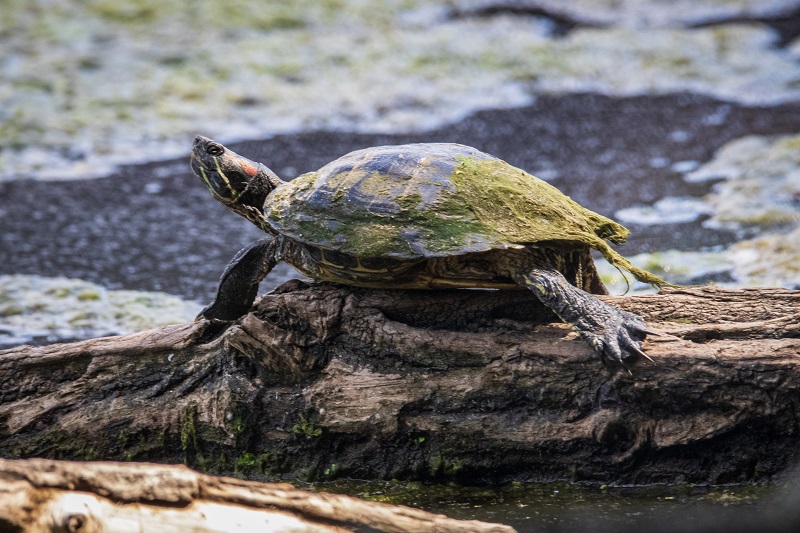
 WildlifeNYC311
WildlifeNYC311 Search all NYC.gov websites
Search all NYC.gov websites
Freshwater Turtles and Terrapins
Freshwater Turtles and Terrapins

Introduction
New York City’s turtles are the perfect gateway into the world of urban wildlife appreciation. Their prevalence in and around the city’s waterbodies means spotting one isn’t very difficult. And their slow-moving nature makes them easier to sit back and admire than some of the area’s more mobile species.
Turtles in NYC, like their human counterparts, are very diverse. Several turtle species call the city home. From big, prehistoric-looking common snapping turtles (Chelydra serpentina) to smaller, water-loving diamondback terrapins (Malaclemys terrapin), there’s no shortage of variety when it comes to these hard-shelled reptiles.

A diamondback terrapin resting on a shoreline.
General Information
Background
Despite their differences, all turtle species have one thing in common: their protective shells. Turtles retreat into their shells for protection against predators. Each turtle shell is unique. But they all include an upper portion, called a carapace, and a lower portion, called a plastron.
Another thing most turtles in New York have in common is their preference for living in and around freshwater. The only exceptions are diamondback terrapins. Diamondback terrapins prefer brackish water. Brackish water is a mixture of freshwater and saltwater. They are the only turtle species in North America to live in brackish water.
It’s important to note that not every turtle found in NYC’s natural areas is a native species. Red-eared sliders (Trachemys scripta elegans), one of the most common turtles found in the city’s parks, are invasive. This species was likely released in the area by pet owners who could no longer care for them. Red-eared sliders' adaptability has allowed them to thrive in ponds, lakes, and other waterbodies in the city. They can outcompete native species for food and other resources, which makes it harder for native wildlife species to survive. Unwanted pet turtles should never be released into parks and natural areas. Their overabundance can lead to the elimination of native wildlife.
Appearance
Each turtle species has a unique look. Invasive red-eared sliders are named for the streaks of red found along the sides of their heads. They also have dark-green skin with bright yellow streaks throughout. Native painted turtles (Chrysemys picta) look similar, but don’t have those same red streaks, and their shells tend to be flatter and smoother on top. They also sometimes have red coloration near the base of their necks. Diamondback terrapins have white or gray skin with black spots and splotches throughout. Their shells are typically brownish-black. Snapping turtles are noted for their long, ridged tails that can measure as long as their shells.
Turtles’ sizes differ based on species too. Snapping turtles are one of the largest turtles in North America. Their shells can measure up to 16 inches long. Most other species’ shell lengths range from about 4 inches to 9 inches long. Females are typically larger than males for many species, including diamondback terrapins.
Behavior
Most turtles nest from late May to early July. During this time they will lay eggs in sand, dirt, gravel, grass, and other loose natural material. You might see them far from water as they venture out to lay their eggs. Eggs will hatch two to three months after being laid, often in mid-August. Turtles that have recently hatched will sometimes overwinter in the ground by burying themselves in soil.
Turtle diets vary by species. Snapping turtles will scavenge for food, eat plant material, and prey on small fish. They will also eat invertebrates, and even young waterfowl. Diamondback terrapins eat aquatic invertebrates like snails and clams. They also eat fish and insects. Painted turtles mostly eat aquatic vegetation and invertebrates. They have also been known to scavenge dead animals.
Turtles are ectotherms. This means they cannot regulate their body temperature internally. As a result, you can often find them sunbathing to warm up. For many turtles, this occurs on the shores of lakes and ponds. On hot days, many species will retreat to nearby water to cool off.
Their body temperatures play a role in their hibernation as well. In winter, many turtles hibernate at the bottom of waterbodies. The cold water lowers their body temperature and metabolism. This allows them to go months without food. In order to breathe, they absorb oxygen from the water through their skin.

A snapping turtle walking on land.
Fast Facts
● Turtles don’t just move slowly; they grow slowly too. It can take between five and 20 years for some species to reach sexual maturity. Most species can live for decades. Some can live for up to 70 or 80 years.
● For many species, the sex of a turtle is determined by the temperature at which their eggs develop. Warmer temperatures tend to produce females. Cooler temperatures tend to produce males.
● When hibernating, a lot of oxygen that turtles absorb from the water is filtered through their cloaca. The cloaca is the part of their body they use to expel waste, lay eggs, and mate. It is located below their tail. Because of this, it is sometimes said that turtles can “breathe through their butts”.
Coexistence Tips
● Stay alert while driving. Turtles will sometimes cross roadways, especially when females are looking for nest sites. Their tough shells are no match for cars and trucks. Many die every year after being hit by vehicles.
● Properly dispose of trash and fishing line. Trash and fishing line that is not placed in proper receptacles can end up in waterbodies. This can entangle and cause harm to turtles and other aquatic wildlife.
● Do not feed turtles. Food handouts are not only bad for turtles’ health, but they can contribute to disease outbreaks and water pollution.
● Appreciate turtles from a distance. As with all wildlife, turtles can become stressed when approached or picked up. Snapping turtles also have powerful jaws. They can bite if they feel threatened.
● Do not release pet turtles. Unwanted pet turtles released into the wild often either do not survive, or outcompete native species for resources. For their health and the health of the environment, find new homes or sanctuaries for unwanted pets.

A red-eared slider sunbathing on a log.


